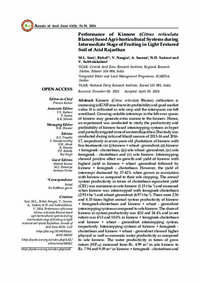Performance of Kinnow (Citrus reticulata Blanco) based Agri-horticultural Systems during Intermediate Stage of Fruiting in Light Textured Soil of Arid Rajasthan

Authors:
Kinnow (Citrus reticulata Blanco) cultivation is increasing in IGNP area due to its profitability and good market value. It is cultivated as sole crop and the interspaces are left unutilized. Growing suitable intercrops in the leftover spaces of kinnow may generate extra income to the farmers. Hence, an experiment was conducted to study the productivity and profitability of kinnow-based intercropping systems in hyper-arid partially irrigated zone of western Rajasthan. The study was conducted during rabi and kharif seasons of 2015-16 and 2016-17, respectively in seven years old plantations of kinnow with five treatments viz (i) kinnow + wheat - groundnut, (ii) kinnow + fenugreek - clusterbean, (iii) sole wheat -groundnut, (iv) sole fenugreek - clusterbean and (v) sole kinnow. Intercropping showed positive effect on growth and yield of kinnow with highest yield in kinnow + wheat -groundnut followed by kinnow + fenugreek - clusterbean. However, the yield of intercrops decreased by 37-42% when grown in association with kinnow as compared to their sole cropping. The annual system productivity in terms of clusterbean equivalent yield (CEY) was minimum in sole kinnow (1.15 t ha-1) and increased when kinnow was intercropped with fenugreek-cluster bean (2.95 t ha-1) and wheat-groundnut (4.97 t ha-1). There were 2.56 and 4.33 times higher annual system productivity of kinnow + fenugreek-clusterbean and kinnow + wheat - groundnut intercropping system as compared to sole kinnow. The share of kinnow in system productivity was 42.0 and 24.4% and in net return was 43.5 and 18.0% in kinnow + fenugreek-clusterbean and kinnow + wheat - groundnut intercropping system, respectively. Intercropping systems of kinnow + fenugreek - clusterbean and kinnow + wheat - groundnut showed higher physical as well as economic water productivity as compared to sole kinnow. The water productivity in terms of gross return (WPGR) increased from Rs. 4.99 m-3 in sole kinnow to Rs. 7.94 and 9.89 m-3 in kinnow + fenugreek - clusterbean and kinnow + wheat -groundnut intercropping systems, respectively. Net return and BCR of intercropping systems were more as compared to sole kinnow which indicated that the intercropping systems of kinnow provides higher economic benefits through additional return from crop produce.
